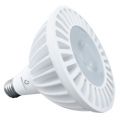Different Types of LED Lights

If you’ve been shopping for a new look for your home or patio, you’ve probably encountered several lighting options. One of the most popular choices is light-emitting diode (LED) technology. Many types of LED bulbs are available for both residential and industrial uses.
Why LED Lights Are So Popular
LED bulbs represent one of the most energy-efficient technologies ever developed, according to the U.S. Department of Energy (DOE). The agency says that when compared to incandescent lights, LEDS can last up to 25 times longer and utilize 75 percent less energy.
LEDs differ from other sources of lighting in a number of ways. The light source is often tiny, about the size of fleck of pepper. One reason the technology is so efficient is that it gives off light in a particular direction, cutting the need for reflectors and diffusers. This makes LEDs ideal for uses like recessed downlights.
Consumers like LEDs because they also give off little heat when compared to more traditional sources of lighting like incandescent bulbs. Among commercial and industrial uses are street lights, refrigerated case lighting and lighting in parking garages and walkways.
Because they’re so small, LEDs are good choices for home uses like kitchen countertop lighting. They’re also popular for use in residential bathrooms and hallways. The DOE says retailers sell more than 20 million recessed downlights each year and estimates that 500 million of them have been installed in American homes. The flashlight or the holiday lights you last bought probably used LED technology.
Types of LED Lights
LED lights come in many sizes and shapes such as PAR38, miniatures and more:
- Miniatures. They’re the most common style. Examples are the green “on” light you see on your computer or cell phone. Manufacturers usually produce minis in just one shape and color. They’re easy to place on a circuit board because of their size and don’t require any device for heating or cooling. For these reasons, they’re particularly popular for highly automated industrial uses. Subtypes vary according to the voltage, wattage and current selected by the manufacturer.
- High-powered. The technology is so powerful that chips can emit light reaching several thousand lumens. Several subtypes differ from each other in terms of wavelength, intensity and voltage. You’ve seen this type of LED in high-powered lamps, headlights of cars or medical settings requiring intense light. One potential danger is overheating, so use requires careful mounting for proper cooling.
- Application-specific lights. You’ve seen several types of them. An example of a flash LED is a standalone OPEN/CLOSED sign for a business. Multiple-colored lights include Bi-colors and Tri-colors. Red/green/blue (RGB) LEDs feature a technology that can combine the three colors and produce new hues very precisely for light shows or accent lighting. Alphanumeric LEDs are sometimes used for effects requiring the use of numbers of letters of the alphabet.
EnergyStar.gov wants consumers to know that LED light products with the Energy Star designation have complied with more than 30 industry procedures and standards. Each also comes with at least a three-year warranty.
Other articles and publications:
- +1 (800) 492-9660
- 3720 Commerce Drive, Suite 1104
- www.lightbulbwholesaler.com


